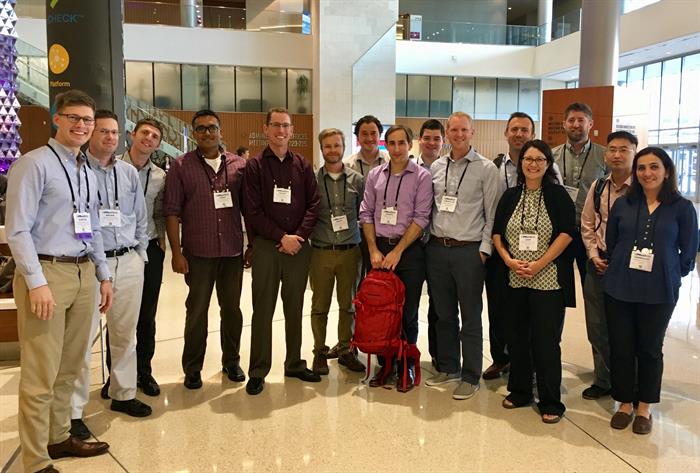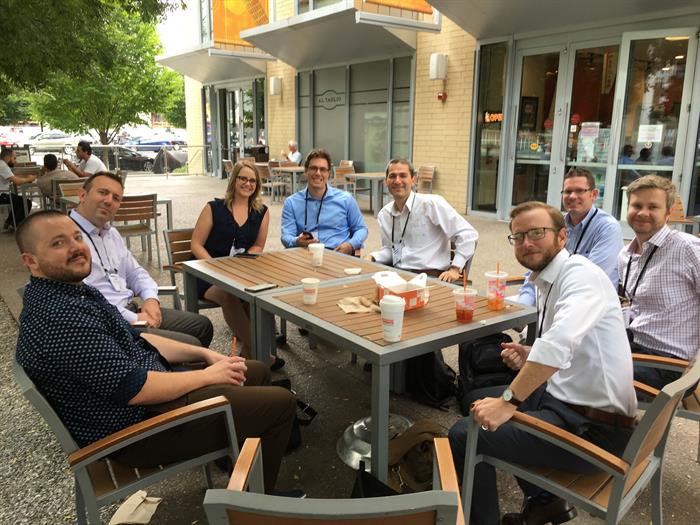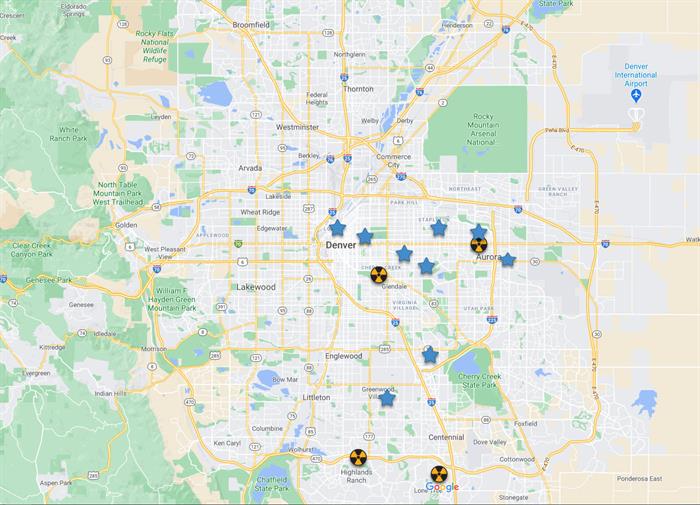Frequently Asked Questions
How are the rotations structured? Are there multiple campuses for the rotations?
Our program is structured into 9 rotations, each between 2 and 4.5 months long. Each rotation is overseen by a chief rotation mentor along with two additional faculty that have specialties in the field of study. Rotations are designed with detailed goals and objectives which describe the specific knowledge, skills, and topics of study for the rotation.
All rotations are held at the Anschutz Medical Campus (AMC) in Aurora, CO, however the residents spend a short period of time at satellite clinics for specific training purposes. Residents are also able to spend a day shadowing physicists at UCHealth Memorial Hospital to participate in procedures not available at AMC, such as intraoperative breast radiotherapy.
How is resident progress assessed?
Resident progress is assessed formally in a number of ways, including:
- Regular meetings with rotation mentors and the Program Director
- End of rotation Q&A
- Skills exams
- Annual oral exams
Our program encourages open communication between faculty and residents. This allows for frequent informal feedback, which is critical for effective training.
Are there research expectations for residents in your program? If so, what kind of research is currently available?
Given we are a two-year program, we do not require residents to perform research during their time with us.
As an alternative, we provide a two-month rotation solely focused on clinical development and emerging topics. During this rotation, residents will participate in the development and implementation of new technologies into the clinic. The outcome of the rotation can be a new clinical tool, commissioning report, presentation to staff, or abstract to a professional meeting.
Additionally, if the resident is interested in research and they are meeting program expectations, they are able to pursue research on their own time. Our physics faculty lead active research programs of a wide variety of topics, so there are ample research opportunities available.
How are residents paired with mentors? Are they paired with a single mentor or will they be expected to work on a new project each rotation?
Each clinical rotation is overseen by a chief rotation mentor who is responsible for managing the rotation to ensure the resident completes rotation goals and objectives. Two additional faculty that have specialties in the field of study are also assigned to each rotation.
This doesn’t mean that the resident will solely work with the chief mentor and assigned faculty during a given rotation. Our department is a mid-sized department with the physics group working closely together. The advantage of our size is that the resident will interact with any, if not all, physicist throughout the rotation. All physicists actively participate in the training of the resident.
During the clinical development and emerging topics rotation, a chief rotation mentor and additional faculty are assigned to the resident. Depending on the specific topic of clinical development, the resident will also work closely with the physicist involved with the particular project or who has the expertise in the clinical area.
What consistent clinical responsibilities do your residents have (machine QA, chart checks, IMRT QA, physicist of the day, etc.)?
Residents are integrated into the physics group and shares responsibilities in the clinic. While this provides the residents with the necessary skills to function as independent, competent clinical physicists upon graduation from our program, we also aim to maintain the optimal balance between clinical responsibilities and time for training and learning.
Clinical responsibilities include in vivo dosimetry, CT simulator QA, linac QA, IMRT QA (~ 1 week in every 6 weeks), HDR afterloader QA and radioactive source shipping and receiving during brachytherapy rotation, radiation detector maintenance program, and co-physicist of the day providing clinical coverage and troubleshooting during the second year.
Will there be commissioning opportunities in the near future? Of what equipment?
Our department is always expanding! Residents work with faculty on a wide variety of commissioning activities, from new brachytherapy applicators to motion management systems and even entire radiation oncology facilities, throughout their time in the program.
2020 - residents participated in the commissioning of a new radiation oncology center in Denver’s Cherry Creek neighborhood.
2021 - residents participated on a team of physicists in the commissioning of a new Varian Edge linac on the Anschutz Medical Campus.
2022 - residents participated in commissioning a new satellite facility in Longmont, Colorado.
2023 - residents participated in commissioning a new Varian TrueBeam with the physicists in Colorado Springs, Colorado.
2024 - residents participated in commissioning a new Varian TrueBeam at one of satellite clinics, a major Eclipse/ARIA upgrade, and a new Bravos HDR remote afterloader
In order to ensure that all residents are trained in commissioning, independent of the clinical events in our department, the last two rotations in our program are dedicated to commissioning (including beam modeling, shielding, and new facility considerations). This was designed to serve as a capstone, as the topics from the previous rotations are revisited in a comprehensive manner.

What distinguishes your residency program from other programs?
- Clinical competency – our goal is to produce fully-capable, independent clinical medical physicists. Our hands-on teaching and curriculum are specifically geared to do just that. Residents graduate from our program well trained with exceptional clinical skills.
- Organization – Two years is a short amount of time to learn so much. Organization is a key aspect of our program that ensures that we cover the necessary topics, and more. Our program is well organization and structured from day 1 to ensure that we make the most out of your two years here at the Anschutz Medical Campus. From rotations to presentations and beyond, we will provide you with the tools and time to craft you into a successful graduate.
- Involved faculty – Our faculty don’t sit by the sidelines. They are directly involved with your education because they understand the importance of doing so, and just as you do, they care about producing the next generation of great medical physicists. At the University of Colorado, residents are not “just” trainees – you’re a part of the team.
- Continuous improvement – we believe that any good training program needs to continuously evolve. There is always a better way to teach something in the program. Furthermore, the radiation oncology field advances so quickly that medical physics residency programs should do the same. Each year, we focus on different areas of curriculum to innovate, such as developing a new training curriculum for physics plan reviews and chart checks. In recent year, residents piloted involvement in the AAPM Mentorship Program and the AAPM/MPLA Cohort Program.
What opportunities are there for residents to teach?
Residents are required to make a presentation to the entire department on a topic of their choice. This presents them with a unique opportunity to develop communication skills needed by physicists practicing in the clinic: how to present complex material to a broad audience.
Second-year residents transition to the role of chief resident. While in this role, the resident provide key mentorship and guidance to the first-year resident.
Residents are not required to teach lectures in our existing classroom education within the department. However, if residents are in good standing in the program, they may choose to be involved in educational activities or development if they are interested.
How are the residents trained in treatment planning? Which treatment planning systems are available?
The training in treatment planning is one of the highlights of our program. Residents are fully incorporated in dosimetry. The 4.5 month treatment planning rotation is overseen by our senior physics faculty who is also the dosimetry supervisor. Residents will become competent in Eclipse and Brachyvision treatment planning software.
During this rotation, the resident will learn the fundamentals of 3DCRT, IMRT, and VMAT planning for various disease sites. Once the resident becomes competent, they perform planning on clinical cases under supervision of dosimetrists and physicists.
Residents also learn important soft skills, including communication, multi-tasking, and prioritization, as they work closely with physician attendings and physician residents during this time.
Our program also has a specialized rotation focused on SRS and SBRT, during which the resident will be trained on SRS/SBRT planning.
Do the residents have opportunities to travel to conferences? Which ones? To present or just to attend?
Yes! Our program provides funding for residents to travel to one national conference during their time with us. An abstract submission is not required. Residents typically choose to attend the AAPM Annual Meeting between their first and second years in the program, but other options, such as the AAPM Spring Meeting, AAPM Summer School, or ASTRO Annual Meeting, are available.
Is conference travel funded by your program?
Yes! Our program funds travel to one conference during the resident’s time in our program. This includes airfare, hotel, transportation, and per diem within standard university guidelines.
Does your program have an educational fund for residents?
Yes! Residents are provided with education funds over the course of two years. Purchases must be made within university policy and with the approval of the program director



What do benefits (e.g. health, dental, and vision insurance, retirement plans, etc.) include?
Residents are university employees and are thus provided with health, dental, vision, disability and basic life insurance. Voluntary retirement plans are available as well. Residents receive 12 vacation days plus approximately 3 banked holidays per year and 12 sick days per year, as well as duty hour leave as per program policies.
Do most residents commute to work? How long is the commute?
Typically, residents will commute to campus, depending on their living situation. There is a variety of housing options in the Denver metro area, including close to campus, within the downtown Denver area, as well as numerous Denver neighborhood and nearby suburbs. Previous residents have lived within walking distance, 15 minutes, 30 minutes, and 45 minutes from campus. On the below map, we've highlighted where previous residents have lived (blue stars) relative to our department and satellite clinics (radiation symbols).

Is parking available on campus? Or do most residents rely on public transportation?
Parking is available on campus for a monthly fee, as well as a broad selection of public transportation options.
Do you have/have you had international residents that required a VISA?Yes, we have previously had international residents on visas. We evaluate visa needs on a case by case basis during the admissions process.
What is the onboarding process for foreign residents at your institution? Work VISA (H1B)? OPT?
As soon as match results are released, our department’s personnel liaison will work closely with our international office to start the processing requirements.
To whom may I address any additional questions?
Please forward any additional questions to our Program Coordinator